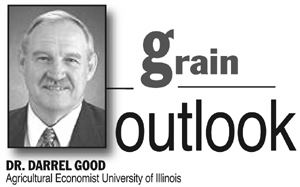|
Corn Price Premiums Continue To Fade

Corn was the primary focus of the agricultural commodity complex beginning in the 2006-07 marketing year and continuing through the 2012-13 marketing year. Corn prices during that period were supported by a rapidly growing domestic ethanol industry that required more acres of corn and by relatively poor U.S. corn yields in 2010, 2011, and especially in 2012 that kept corn supplies very tight.
The dominant role of corn prices in the crop sector during that seven year period is revealed by the ratio of marketing year average prices. The ratio of the average farm price received for soybeans and corn was 2.83 for the 2005-06 marketing year and averaged only 2.28 for the period from 2006-07 through 2012-13. Similarly, the ratio of the average farm price received for wheat and corn was 1.71 for the 2005-06 marketing year and averaged only 1.34 for the period from 2006-07 through 2012-13. The ratio of the price of soybean meal in central Illinois and the average farm price of corn (on a per pound basis ) was 2.44 for the 2005-06 marketing year and averaged only 2.06 for the period from 2006-07 through 2012-13. Corn, wheat, soybean, and soybean meal prices during the seven year period were all high relative to livestock and livestock product prices as evidenced by declining livestock/feed price ratios. The ratio of specific livestock or livestock product prices to feed prices reached the lowest levels at different times that ranged from July 2012 through August 2013.
The premium of corn prices relative to other crop prices began to fade during the 2013-14 marketing year. Current estimates or forecasts for the 2013-14 marketing year reflect a soybean/corn price ratio of 2.92, a wheat/corn price ratio of 1.54, and a soybean meal/corn price ratio of 3.02. The soybean/corn price ratio will be higher than in the 2005-06 marketing year. Increasing livestock prices and declining feed prices have restored livestock/feed price ratios to the highest levels in at least four years.
The price of corn for the 2014-15 marketing year has declined by about $1.25 since early May and the price of corn relative to most other agricultural commodity prices has declined sharply. Based on the closing prices for December 2014 futures (November 2014 futures for soybeans) on May 9, 2014 and July 18, 2014 the soybean/corn price ratio increased from 2.46 to 2.87 and the soybean meal/corn price ratio increased from 2.18 to 2.60. The wheat/corn price ratio is about unchanged at 1.5. The most dramatic changes have been in the livestock/corn price ratios. The lean hog/corn price ratio increased from 18.86 to 27.37, the live cattle/corn price ratio increased from 29.03 to 40.83, and the milk/corn price ratio increased from 3.73 to 5.02.
The soybean/corn price ratio is of particular interest. In the July WASDE report, the USDA forecast 2014-15 marketing year ending stocks of corn at 1.801 billion bushels, which represents a marketing year ending stocks-to use ratio of 13.5 percent. Similarly, marketing year ending stocks of soybeans were forecast at 415 million bushels, which represents a marketing year ending stocks-to-use ratio of 11.7 percent. On the surface, similar stock levels for corn and soybeans would suggest that the soybean/corn price ratio would be near a more normal level of about 2.4. As indicated, the current new crop futures price ratio is near 2.9. Based on harvest delivery cash bids in central Illinois, the current soybean/corn price ratio is 3.05. Prices are still adjusting to supply and consumption prospects for the upcoming marketing year so that price ratios may continue to change. However, the declining and increasingly low price of corn relative to soybeans suggests that the market currently expects the marketing year-ending stocks-to-use ratio for corn to be much larger than projected by the USDA. Such expectations are based on expectations of a much higher corn yield and a much larger corn crop than forecast in the July WASDE report. As suggested in last week’s newsletter, even a yield about five bushels higher than forecast by the USDA would not point to average prices as low as currently reflected in the market. Yield expectations are obviously increasing as the growing season progresses and widespread and persistent stressful weather is avoided.
If the 2014 corn crop reaches the lofty levels currently expected, the key to prices after harvest will be the response by users of corn. The low price of corn relative to livestock prices, relative to other feed ingredients, and relative to ethanol prices points to the potential for a surprisingly large consumption response. In that case, the seasonal pattern of corn prices during the 2014-15 marketing year would be expected to follow a more typical large crop pattern – lowest near harvest and then increasing as the marketing year progresses. The USDA’s first survey-based forecast of the size of the U.S. corn crop to be released in three weeks will go a long way in determining the likely level and pattern of corn prices during the year ahead. ∆
DR. DARREL GOOD: Agricultural Economist, University of Illinois
|
|